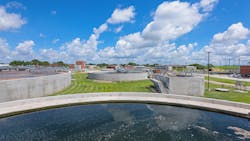Tapping Into a Lower Carbon Footprint
For wastewater utilities, becoming more energy-efficient is not only an economically wise decision but also demonstrates local responsibility, creates a sense of pride among employees and reduces the global carbon footprint. The wastewater sector naturally accounts for a great deal of total energy use and thereby greenhouse gas (GHG) emissions with large pumps, aeration blowers and equipment motors. A variety of quickly evolving energy-efficient solutions exist to replace these parts to reduce energy usage in a plant.
Fitting Unique Needs
Many wastewater utilities were previously hesitant to install more efficient pumps or blowers due to the upfront cost associated with implementation. Over the past decade, innovation and more widespread energy-efficient technology use has led to an increase in budget-friendly solutions such as replacing lighting fixtures or pumps.
A third-party company could also provide the additional funds to utilities necessary for implementing more energy-efficient solutions. For example, a qualified engineering firm capable of designing and/or installing energy efficient solutions at the facility could potentially finance the capital project to reduce energy usage. The utility would then pay back the initial capital investment over time using the energy cost savings and an agreed-upon payment plan.
Reaching Goals
Energy-efficient solutions also work as a way for utilities to meet established energy reduction goals. For example, the Danish water sector has set a goal of net-zero energy-usage, or producing enough renewable energy to match consumption needs, by 2030. The idea of net-zero energy has been a popular idea for many communities but in practice is often difficult for utilities to implement without a plan and designated funds. Utilities can reduce energy usage with more efficient blowers, pumps and lights to not only reduce financial costs associated with running plants but also shrink their carbon footprint.
Renewable natural gas (RNG) solutions can also provide some economic relief for many wastewater utilities.
A wastewater plant in Downers Grove, Ill., has saved on electricity bills and received grant money from the Illinois Clean Energy Community Foundation for being a net-zero-energy facility through the implementation of several energy-efficient processes. One of the main components in reducing the energy use and greenhouse gas (GHG) emissions has been the installation of a Danish solution — cost-efficient combined heat and power (CHP) units — to start producing energy. This has helped the plant to reduce energy and ultimately reduce carbon output from equipment used.
Developing a sustainable wastewater solution is often a unique fit dependent on the challenges and budgetary constraints a utility faces. With proper planning, utilities can implement a solution that not only promotes economic savings but also promotes an environmentally beneficial energy usage plan. WW
About the Author: Patrick Clifford is a regional practice manager at Burns & McDonnell. In his role, he helps provide water industry clients with engineer-procure-construct (EPC) and other alternative project delivery solutions.
About the Author

Patrick Clifford
Patrick Clifford is a regional practice manager at Burns & McDonnell. In his role, he helps provide water industry clients with engineer-procure-construct (EPC) and other alternative project delivery solutions.

